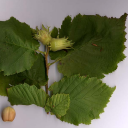Search
About Corylus avellana
The genus Corylus describes hazels, deciduous trees and large shrubs that are widespread throughout the northern hemisphere and are grown for their edible nuts, wood and ornamental purposes. The most economically significant species is the diploid (2n=22) European hazel (Corylus avellana L.), the nuts of which are known as hazelnuts, filberts or cobnuts, and are consumed worldwide both directly and as an ingredient in many food and confectionary products. Hazelnuts prefer a mild, damp climate; historically, production is concentrated in Turkey, Italy, Azerbaijan and the USA. In recent years several other countries have begun actively developing their hazelnut industry, such as China, Georgia, Iran and Chile.
As with many tree species, C. avellana has a long generation time (up to 8 years to reach full productivity) and also displays sporophytic self-incompatibility, with genetically similar individuals unable to pollinate each other. These factors make selecting for many important traits by classical breeding approaches extremely difficult. Therefore, genomic data, which allows the identification and selection of many genetic loci simultaneously, has huge potential to accelerate the research and breeding of hazel.
Taxonomy ID 13451
Data source SUNUM
Comparative genomics
What can I find? Homologues, gene trees, and whole genome alignments across multiple species.
 More about comparative analyses
More about comparative analyses
 Phylogenetic overview of gene families
Phylogenetic overview of gene families
 Download alignments (EMF)
Download alignments (EMF)
Variation
This species currently has no variation database. However you can process your own variants using the Variant Effect Predictor:






 Display your data in Ensembl Plants
Display your data in Ensembl Plants

 Update your old Ensembl IDs
Update your old Ensembl IDs

![Follow us on Twitter! [twitter logo]](/i/twitter.png)
